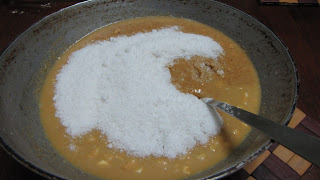I am surprised to hear
many people do not consume snake gourd. I don’t remember any vegetable that was
avoided in my mom’s kitchen. We were strongly discouraged to have any favorism for a particular vegetable; we simply were not allowed to avoid a veggie though
we are choosy at times about what is cooked with it. This starter recipe can
actually get you started with eating snake gourd if you are not used to it.
Preparation
Time: 10 minutes
Cooking
Time: 10 minutes
Serves: Yields 15 kebabs approx
Ingredients:
1. Snake
gourd – 1 medium sized
2. Boiled and peeled potato
– 1 large
3. Capsicum
– 1 small
4. Bread
crumbs – 1 cup
5. Corn
flour – 3 tbsp
6. Cumin
powder – ¼ tsp
7. Pepper
crushed – ¼ tsp
8. Chaat
masala – ½ tsp
9. Chili
powder – ¼
10.
Salt as per taste
11.
Lemon juice – 2 tbsp
12.
Cardamom powder – 1 pinch
13.
Sugar – ¼ tsp
14.
Oil for deep frying
Method:
Step 1: Peel and grate the snake gourd; mash the potato.
Step 2: Now in a mixing
bowl, mix together all the ingredients except bread crumbs and oil.
Step 3: Check the taste
and adjust consistency by adding bread crumbs to get a soft but not watery mix
such that you can mould them with your fist.
Step 4: Shape them into
finger length cylinders like in the picture below and roll them on bread crumbs.
Repeat for the entire mix.
Step 5: Heat oil in a
kadai and deep fry the kebabs until they get a nice brown color.
Step 6: Serve hot with
ketchup or green chutney.
TIPS:
*You can prepare and refrigerate
the rolled kebabs in advance to fry while serving; especially when made for
guests we don’t want to do messy things in the last minute in front of them.































